Shield AI has announced the X-BAT, an artificial intelligence-piloted vertical takeoff and landing (VTOL) fighter jet designed to operate without traditional runways and to function in highly contested environments, the company stated.
According to Shield AI, the X-BAT is powered by the firm’s Hivemind autonomy software, which enables the aircraft to operate in communications-denied or degraded conditions, fly independently or in coordination with manned aircraft, and carry out a variety of missions without direct operator control. The system is intended to allow the aircraft to act as an autonomous “drone wingman” or a standalone combat platform.
“X-BAT represents the next part of that plan, expanding U.S. and allied warfighting capacity through a transformative, runway-independent aircraft,” said Brandon Tseng, Shield AI co-founder, president, and former Navy SEAL, in the company’s announcement. “Airpower without runways is the holy grail of deterrence. It gives our forces persistence, reach, and survivability, and it buys diplomacy another day.”
Shield AI claims that the aircraft combines range, flexibility, and autonomy in a compact design. The company lists a range of over 2,000 nautical miles with a full mission payload, a multirole configuration for strike, electronic warfare, and reconnaissance missions, and a footprint small enough for three aircraft to fit into the deck space of a single fighter or helicopter.
Armor Harris, Shield AI’s senior vice president of aircraft, described the design as “a revolution in airpower because it combines four things – VTOL, range, multirole capability, and autonomy.” Harris added that X-BAT’s autonomous operation “simplifies kill chains” and reduces reliance on refueling and established runways.
The company stated that X-BAT is intended to provide fighter-class performance at a significantly lower acquisition and lifecycle cost than fifth-generation aircraft, while offering enhanced survivability through autonomy and signature management.
The aircraft was unveiled at an event in Washington, D.C., attended by U.S. defence officials, industry leaders, and members of Congress. Shield AI said the program represents the next phase of its efforts to integrate artificial intelligence into combat aviation, following its earlier V-BAT drone program.


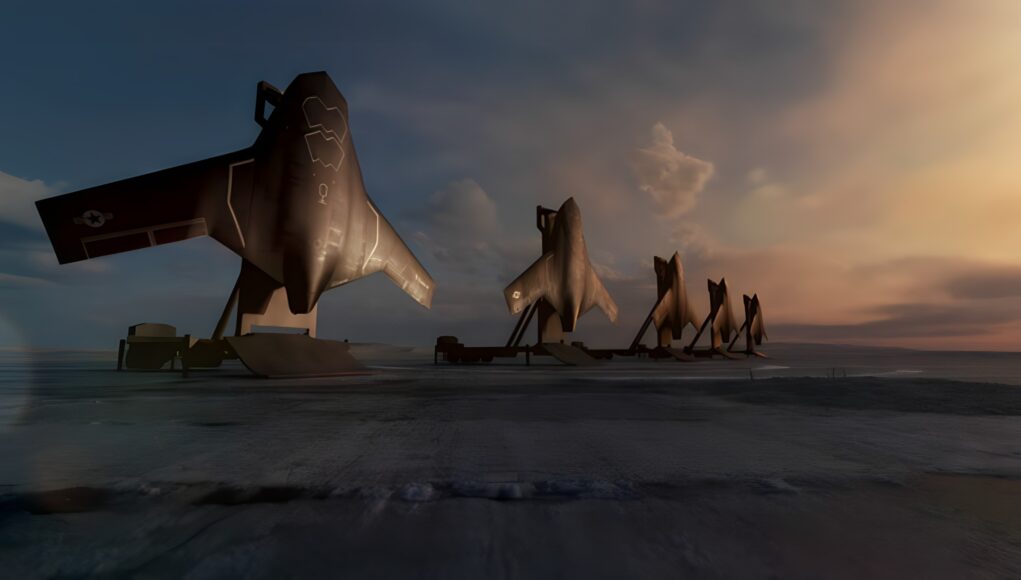
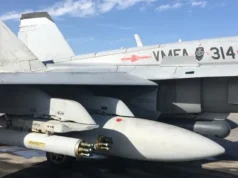

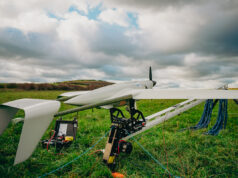
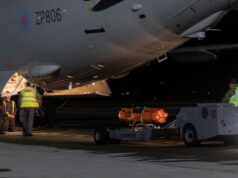
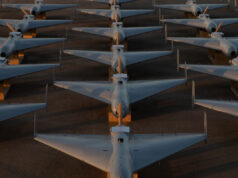
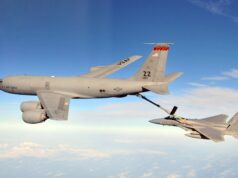
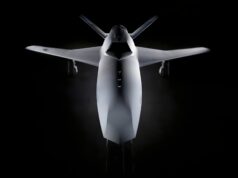

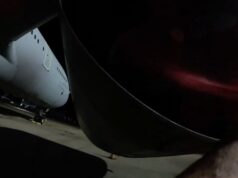
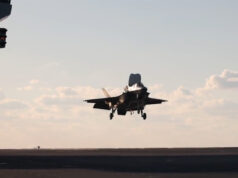

“significantly lower acquisition and lifecycle cost than fifth-generation aircraft”
Does anyone else think that still sounds really expensive?
The Register have a piece that suggests around $30m. I have real trouble believing in that. It also says the company have called it attritable. Probably not if you are British. And the article goes on to suggest the RN’s Project Vanquish is a possible customer.
If you are expecting it to perform just as well as a manned fighter. Then the powerplant, avionics etc will also need match that. There no point putting a mickey mouse radar in it, if it can only detect objects 50km away and arming with a medium range beyond visual range air to air missile (BVRAAM). S you’re not maximizing the potential of the missile. If the UAV is being used as a dumb bomb truck controlled by a manned aircraft, then it won’t need the avionics.
According to a set of press Q&A, the X-Bat is powered by the F100/F110 engine as used by the F16. Due to aerodynamic efficiency of the shape, they are predicting a range of over 2000km, but also a speed comparable to the F16.
The vertical take off and landing principle was initially hard to figure out, especially as it was recovering on to the trailer’s launch rail. But apparently they are basing it on the X-13 Vertijet trialled in the 1950’s, along with the recovery methods used by the SpaceX’s Falcon rocket. The X-Bat uses a 3D engine exhaust nozzle to control its landing attitude and hover. Apparently it works in simulations, they are planning on doing the physical trials next year.
Shield AI have been saying that something like a LHD, LPD or even the Independence class ships, could be used as carriers for these UAVs
‘Works in simulations’ perhaps I shouldn’t be cynical but mentioning the Vertijet and Falcon obscurely in one sentence as if there is any real overlap hardly impresses me, they may as well referenced the Moon Rocket in Tin Tin, the Triebflügel, the Lockheed XFV, Pogo or the Lunar Module even as inspirations if they want to be fanciful, but surely the Delta Clipper was worth a mention or was that not something they wanted to be associated with. If this concept has legs (pun intended) then great, but probably better to get real and prove the concept rather than fancifully cherrypick a couple of unrelated projects to hype the idea as if it’s proven by association.
The designer of this worked at spacex as the lead engineer of the falcon 9 booster landing. This will have 3d thrust vectoring and above 1:1 thrust/weight ratio. Theres not really a reason it shouldn’t work… I thought the falcon 9 sounded ridiculous as well, and look at it now. Shield AI has also had fully autonomous (independent of GPS or physical control) drones operating in Ukraine since the beginning. I’d invest in this company if I could…
So, How many have they built ?
First flight is scheduled for next year, with production planned for 2029.
The amount of smaller companies coming out with CCA designs in the US reminds me of the early Cold War and the amount of companies building jets for the USAF.
No harm in small innovators at all.
Absolutely, it’s good to see.
Its really exciting to see the silicon valley talent going all in on defense lately. Anduril is another company doing things at incredible pace. They’ve got everything from massive underwater AI subs (which austrailia is getting) to aircraft, drones, cruise missiles and augmented reality goggles for soldiers. And thats just one of many startups. its hard to keep track of all the new ones that have come online in just the last few years.
If it works as stated. Brilliant, finally something to fit on an RN carrier.
How does it land?
The USN tried tail sitters in the 1950s, provided sufficient thrust it is very easy to take off but much harder to transition from horizontal flight to vertical when landing.
That was a tremendous period of experimentation, not just in the US but Britain too. Some real leaps were taken back then including flying wings, supersonics and Vertical take off Beds !!!
… with many associated deaths. The Cutlass was a lovely example of what seemed futuristic and innovative yet a death trap.
Now I love the idea of this concept, great if something substantial and practical can come out of it but seriously it shouldn’t be underestimated how difficult and potentially dangerous landing a large ‘hot’ tail sitter onto a carrier would be. If they want to bring up and compare to Falcon well just check out what happens when a landing goes wrong on one of their unmanned barges the operative word being ‘unmanned’ … and that’s for a good reason and they do it in flat calm and benign conditions.
It’s not magic just maths!
They have taken the fundamentals used with the Ryan X-13 Vertijet, but updated with modern technology and the systems processes used by the SpaceX Falcon rocket. It is launched from a rail raised vertical from a trailer. The F16 derived engine gives it a greater power to weight ratio for vertical take off. Where at x height/speed it transitions into forward flight.
When coming in to land, apparently it will perform a “cobra” manoeuvre. This is to make sure there is still sufficient air flow into the nose air intake for the engine. When vertical it will use its 3D vectoring engine exhaust nozzle to control its attitude and descent as per the Falcon rocket. Apparently one of the people from SpaceX is working for them. When near the trailer, the vertical rail captures the UAV. According to Shield AI, the engine has sufficient power to allow the UAV to hover whilst only using dry power (not reheat).
Simples, well according to simulations. The physical trials start next year, so wait and see if they got their calculation right!
So they are going for the traditional tail-sitter landing then! It’s interesting that they are using SpaceX tech, it shows that reusable rocketry is now so mainstream that it is spilling over into other areas of aerospace.
PS love that description of engineering at the top 👍
The CTO came from space-X
I for one will do so avidly. Lots of Starship engineers have been leaving this year we can speculate as to why. Thrust controlled tail landings have been done since at least the 90s and before Falcon managed it but using it for good and practical purpose has been the real challenge, you certainly don’t do it unless you really gain great advantage from it or have to and it’s to be noted that Starship hasn’t actually only managed it once partly successfully and no attempt yet for a capture, the loss to a tower is presently too big a risk, but the X-Bat should be potentially much easier a proposition. However reliably turning a standard jet engine as they need to as reliably as required on a constant basis will be a considerable obstacle I suspect. After all early F-14s using not dissimilar and well understood engines in their early operational years, exacerbated by their widely spread location on the airframe caused flame outs purely by participating in dog fight manoeuvres and that took years to solve. If this solution can be made to work, great but my initial thoughts for this type of drone is that perhaps a simpler landing technique might be preferable. After all a failure could be catastrophic to a carrier.
There is an inherent risk, as Space X have found out with recovering an object by using a tail sitting landing/recovery. In essence it seems logical if you can launch vertically, then landing the same way shouldn’t be a problem, right?
Space X actually has it easier. As they’re using a liquid fueled rocket, which is gimbaled. Meaning it can be turned on and off as required.
For Shield AI it’s a lot more difficult. As they’re using low bypass turbofan. Which means it needs a constant and smooth flow of air to feed it. If you look at the nose area of the X-Bat, you’ll see it has a very wide mouth like air intake. But also the shape underneath the intake is a large radiused bulge.
The cobra is a positive g manoeuvre. However, the abrupt style of it could cause flow separation, especially on the intake’s lip. So they’ve given the intake a very wide mouth and the smooth bulge, to make sure the air doesn’t spill off or get blocked from entering the intake.
They’ve done modeling and simulations, along with air tunnel testing to “prove that it works”. But it will only really be validated by doing full size physical testing.
If it works and they can repeatably do the recapture landing. Then they may be onto something. As a tail sitting landing is much more suited to a UAV, rather than crewed aircraft. As the pilot’s orientation is no longer a factor. However, you wouldn’t be able to do this with a tanker type of UAV, firstly because of the take-off weight, but bless it has rocket assistance. But more importantly is the bring back weight for landing. You’d have to dump a lot of fuel during flight to make sure the UAV has the right power to weight ratio. Otherwise you’ll be dumping any spare fuel so it can be recaptured vertically.
Due to the inherent risk of an engine flame out or surge, especially during landing and recapture. I don’t see these being lined up on a deck, being launched and recovered simultaneously. But will this risk, be any different to a F35B vertically landing on a carrier’s deck?
Look up the video of the Ryan X-13. It was doing tail landings/takeoffs in 1957!
Perhaps, despite press speculation, the initial market is dispersed land rather than carrier.
3D thrust vectoring and greater than 1:1 thrust/weight ratio. The lead designer was one of the lead engineers at space x pioneering the falcon 9 booster landing. I bet it’ll work. Can’t wait to see it…
Main picture looks like a cross between the cover of an Asimov book and the Crucifiction.
I must read another of his books soon.
Beautiful illustrations by Chris Foss on those Asimov books, especially Foundation, he was a creative hero of mine as a student, did a lot of album covers too and put forward designs for the spaceships in Alien that though rejected for the alien ship did influence the Earth ship’s design somewhat from memory.
I’m just going to put this out there.. surge, sway, heave, pitch, roll and yaw. These six movements are completely dynamic and completely unpredictable in that there is literally no human or AI way possible to map wave and current activity acting on a ship in a specific timeframe and then translate that into a predictable model of movement.. it’s an impossible task.
Because you have this impossible task you don’t know from one moment to the next where in space the deck you are landing on will be or at what angles it will be at. It’s for this reason carrier based aircraft have very over engineered landing gears and a low centre of gravity.. even naval rotors take this into consideration ( one of the weaknesses of the Puma was that it was not considered safe for carrier operations).. a tail siting lander is the very opposite of everything that improves the safety of Carrier operations how do you have a robust undercarriage on a tale sitter ? How do they keep a tail sitter stable when the deck angle is change on all planes as it lands when it’s centre of gravity will be high with a narrow undercarriage base
Looks a lovely idea for nice stable land based system, looks like a ton of burning debris spilling onto a deck when you add in surge, sway, heave, pitch roll and yaw.
It looks to have the aerodynamic quality of a brick. A VTOL /STOVL UCAV would be very useful but better to reflect on what has worked in the past. A single engined thrust vectoring aircraft ought to be inherently safer to operate. Automated landing controls, now fitted to F18, would allow SRL. The proposed vertical landing looks fraught with risk.
I would like to know more about its lift capabilities. Fuel consumption in vertical flight is high and would surely limit what ordnance or sensor packs could be carried.
Its pretty small and has a small payload. Just 2 amraams. It will be able to achieve >1:1 t/w ratio without reheat. As said this was achieved in 1957 with the Ryan X-13, so with modern engines and materials it should be no problem. The design is optimized for long range so 2000 miles or so.
Long interview with Shield on the Warzone. Seems x BAT is 39ft wide, 26ft long. It uses afterburner for take off but not landing presumably having used or jettisoned most of its fuel load. Not much revealed about payload and range seems to depend on flying high and straight at high subsonic speed.
Seems incredibly ambitious.
Another road to nowhere. This is just typical Yankee blah blah.
Those Boston dynamics robots are the same: pointless,. A border collie would do everything it can do and do it with greater precision and agility. Without the need of a coward hiding behind a joy pad either.
America has reached its ‘lets just bull 💩 about our capabilities’ phase. This company will achieve nothing but a few prototypes and then bankruptcy.
Men with ven and artillery to boot is how you win wars, with big bombs from the sky and big destruction from the water. These tech companies are fooling generals and politicians into thinking they can go to war without the need to use people, it’s a trap and the road to ruin, this mentality is born from sheer cowardice on their part.
Men, guns, bullets, tanks, ships, jets, artillery, shells and then maybe take a risk on one of these toys.